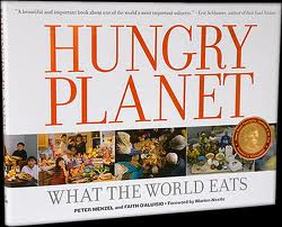Hungry Planet - What the World Eats

From the Foreword by Marion Nestle: Dinner for Six Billion
The authors photographed families throughout the world posed with a display of all the foods they eat in an entire week. The photographs have much to tell us about how people from different countries, cultures, and levels of society feed their families, and the reasons for the similarities and differences. The particular foods purchased or acquired reflect cultural traditions; but they also demonstrate how diet, nutrition, and health depend on less controllable matters such as poverty, conflict and globalization. Together they represent the larger issues that affect us all.
Everyone eats. People around the world differ in many ways, but dinner unites us all.
Every teacher and student/class leader participating in this project should have a personal, hard copy of this book. The book needs to be available to the students at all times so that they can go and get it, look through it, feel the glossy pages, look at the fabulous photos by Peter Menzel, read the stories of each family written by journalist Faith D'Aluisio and the essays contributed by other authors.
This book is appropriate for any age, from toddler to adult. The stories and photos provide the reader with a door to cultivate new perspectives as they meet these families from a wide variety of cultures, and yet there is a commonality among us all.
Recommendation: I hope that you will take time now and then to read one of the family stories to your class. It will provide your students with excellent insights into the lives of people in a variety of cultures. These brief readings are rich material for class discussions.take some time, perhaps once a week, to read one of the family stories to your students. These essays offer rich material for class discussions.
Recommendation: a great project idea for a class, a campus, a district, or a town - let the students create a similar book. They will have to conduct research, interview people in the community, study photography, take photos, write essays . . . and in the end they will have a wonderful, unique product which everyone in the community will want to purchase. So the next step for the students is to develop the business and communication skills to organize a group of business professionals to assist them in getting the book printed so that it can be sold. You could sell them, and allow the students to each have their own copies. Perhaps they could have them signed by some of the families featured in their book!
Think of the content standards, basic skills, knowledge, and 21st century skills that students will develop!
Alternate: instead of making a book about just their community the students could also create their version of a global book as they collaborate with other classrooms around the world.
The book is listed on Amazon.com for about $16 US.
The authors photographed families throughout the world posed with a display of all the foods they eat in an entire week. The photographs have much to tell us about how people from different countries, cultures, and levels of society feed their families, and the reasons for the similarities and differences. The particular foods purchased or acquired reflect cultural traditions; but they also demonstrate how diet, nutrition, and health depend on less controllable matters such as poverty, conflict and globalization. Together they represent the larger issues that affect us all.
Everyone eats. People around the world differ in many ways, but dinner unites us all.
Every teacher and student/class leader participating in this project should have a personal, hard copy of this book. The book needs to be available to the students at all times so that they can go and get it, look through it, feel the glossy pages, look at the fabulous photos by Peter Menzel, read the stories of each family written by journalist Faith D'Aluisio and the essays contributed by other authors.
This book is appropriate for any age, from toddler to adult. The stories and photos provide the reader with a door to cultivate new perspectives as they meet these families from a wide variety of cultures, and yet there is a commonality among us all.
Recommendation: I hope that you will take time now and then to read one of the family stories to your class. It will provide your students with excellent insights into the lives of people in a variety of cultures. These brief readings are rich material for class discussions.take some time, perhaps once a week, to read one of the family stories to your students. These essays offer rich material for class discussions.
Recommendation: a great project idea for a class, a campus, a district, or a town - let the students create a similar book. They will have to conduct research, interview people in the community, study photography, take photos, write essays . . . and in the end they will have a wonderful, unique product which everyone in the community will want to purchase. So the next step for the students is to develop the business and communication skills to organize a group of business professionals to assist them in getting the book printed so that it can be sold. You could sell them, and allow the students to each have their own copies. Perhaps they could have them signed by some of the families featured in their book!
Think of the content standards, basic skills, knowledge, and 21st century skills that students will develop!
Alternate: instead of making a book about just their community the students could also create their version of a global book as they collaborate with other classrooms around the world.
The book is listed on Amazon.com for about $16 US.
